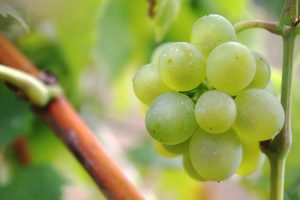Wines from Healthy Vines
Conventionally grown grapes carry so many pesticides that they landed at number seven on a list of most-pesticide-laden produce from the Environmental Working Group. Grapes are sprayed with high levels of insecticide to ward off pests. Vineyards then turn those grapes into wine, bringing those pesticide residues into our drinking glasses.
 A study in 2008 by Pesticide Action Network Europe found that 100% of conventional wines contained pesticides, with as many as 10 different pesticides per bottle. Twenty-four contaminants total were found, including five classified as carcinogenic, mutagenic or endocrine-disrupting by the European Union. Organic and biodynamic wines come without these chemical burdens.
A study in 2008 by Pesticide Action Network Europe found that 100% of conventional wines contained pesticides, with as many as 10 different pesticides per bottle. Twenty-four contaminants total were found, including five classified as carcinogenic, mutagenic or endocrine-disrupting by the European Union. Organic and biodynamic wines come without these chemical burdens.
Reading Labels
Wines bearing a 100% USDA organic label are made from 100% organically grown ingredients. These wines contain only natural sulfites, or sulfur dioxide, in less than 100 parts per million (ppm). Other wines with a USDA organic label are made with 95% organically grown ingredients, with the same sulfite requirements. Labels indicating “made with organic grapes” or “made with organic ingredients” must contain at least 70% organic ingredients. These wines can have artificial sulfites added, but must not contain more than 100 ppm. Wines that go above and beyond USDA organic certification can be certified Biodynamic®.
In 1928, Demeter International formed in Europe to promote biodynamic farming. This farming method approaches the farm as a self-sustaining ecosystem. Demeter’s wine processing standard focuses on minimizing the manipulation of ingredients to allow for the identity of biodynamic ingredients to come through. In the U.S., notes Elizabeth Candelario, marketing director for Demeter USA (www.demeter-usa.org), “almost all biodynamic vineyards are in California and Oregon.”
Animal Friendly
Biodynamic farmers not only avoid synthetic pesticides and fertilizers, but set aside a minimum of 10% of their acreage to biodiversity to promote natural predator-prey relationships to help control pests naturally.
In 1996, Frey Vineyards in Mendocino County, California, became the first winery in the U.S. to be certified Biodynamic®. Frey produces their wines without added sulfites. As Executive Director Katrina Frey points out, “sulfur dioxide is a synthetic preservative that causes adverse reactions for some people, such as headaches and congestion.” Only 10% of the vineyard is set aside for grape vines, the other 90% of the property is wild forestland. Cows, goats and sheep contribute to the health of the farm and its soil by adding nitrogen-rich manure that acts as natural fertilizer.
Healthy Drinking
Not only are organic and biodynamic wines healthier for lack of pesticide residues, they also contain more nutrients and natural antioxidants since they are less processed. When asked about taste, Candelario responds, “there are many wine experts who have noted a difference in the quality of biodynamic wines. As for health [benefits], I can’t speak for the drinker, but definitely for the planet.”
In a blind tasting of 10 pairs of biodynamic and conventionally made wines conducted by Fortune magazine in 2004 and judged by seven wine experts including head sommeliers, nine of the biodynamic wines were judged superior to their conventional counterparts. Biodynamic wines are found to have a better expression of terroir—the way in which a wine represents its specific place of origin, aroma, flavor and texture
Wine bottles are going greener on the outside, too. In the 1920s, around the same time as biodynamic farming got underway, the Swedish packaging company Tetra Pak was founded. Tetra Pak was originally designed as new packaging for milk, but has since been applied to other beverages. A thin film inside the carton protects wine from exposure to sunlight and oxygen, and, according to the Tetra Pak website, the cartons use 92% less packaging, 54% less energy and create 80% less greenhouse gases compared with glass bottles.

